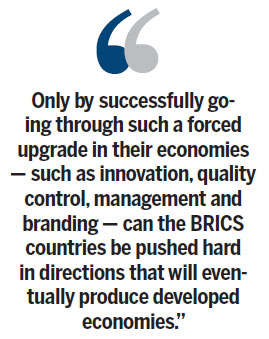Are the BRICS countries losing luster?
Updated: 2013-07-26 11:03
By Zhu Ning (China Daily)
|
|||||||||||

Despite serious challenges, the foundations for growth in emerging economies remain strong
With the expected end of quantitative easing by the US Federal Reserve, global investors are pondering the same billion-dollar question: What should they do with investment opportunities in emerging markets?
On the one hand, emerging markets, which are best represented by the BRICS countries (Brazil, Russia, India, China and South Africa), have been the driving force of global economic growth in the past decade, even after the 2007-08 global financial crisis.
On the other hand, inflation, commodities prices and asset bubbles have slowed down economic growth in the BRICS countries. To complicate matters, such slowdowns have already shown signs of causing social upheaval and political unrest in those countries, and this could further jeopardize the sustainability of future economic growth. As a result, some people have begun to wonder whether the BRICS countries can sustain their stellar growth of the past decade.
Granted, the transition from a middle-income country to a fully developed one is not easy. By adjusting to the real dollar terms, many other countries have also developed from low-income status to middle-income level. Unfortunately, not too many have done this successfully. Some even suffered from problems that caused their economies to falter or even go into recession.
It is important to remember that after countries reached middle-income status, their economies developed in different ways. Singapore and South Korea successfully broke away from the so-called middle-income trap and became fully developed economies.
At the same time, other countries, most notably in South America and Southeast Asia, did not manage to improve their economies. This also adds to some people's concerns about the BRICS countries.
Nevertheless, some basic reasons behind the original propositions about economic growth in the BRICS countries seem to have survived, if not improved gradually. First, these are large countries with large populations and potentially large markets. Second, their relatively young populations are becoming wealthier and gradually forming a growing middle-income class.
Research shows that an emerging middle class is not only crucial to a country's economic growth, but also to its social progress. Such progress will enable the population to better share and enjoy economic growth and will help the country sustain the next stage of growth.
Another important reason to remain bullish about the BRICS countries and emerging markets in general is their potential for growth. Many critics have argued that the underdevelopment of a modern legal framework, the lack of transparency in government operations and the suppression of market forces playing a greater role in the economy may all cause concerns about the BRICS economies.
However true these problems are, it has to be stressed that, because there are so many areas that can and will eventually be improved, the BRICS countries can continue to attract investment. If they can continue to reform their economic, political and social systems, unprecedented productivity and wealth could result.
Also, there are signs that the BRICS countries have gradually become the economic growth centers within their respective regions. If the success of the East Asian region were to be repeated on a greater scale, the transfer of knowledge that would result could sustain economies for a longer period.
As China and Brazil have recently experienced, some multinational companies are moving their operations to cheaper neighboring nations, such as Vietnam, Indonesia, Ecuador and Bolivia.
Some people might worry that such employment migration may cause a slowdown in economic growth in China or Brazil. However, such migration is also evidence that China and Brazil have gradually become the leaders in their respective regions and, with the expansion of neighboring countries' economies and the regional economy, the potential for the Chinese and Brazilian economies to grow further has also been increased.
Japan and South Korea experienced similar transitions in their industries. Only by successfully going through such a forced upgrade in their economies - such as innovation, quality control, management and branding - can the BRICS countries be pushed hard in directions that will eventually produce developed economies.
Another concern with the BRICS countries in the coming decade is that China seems to be doing far better than the others. This may not be such a bad thing. First of all, with the increasing bottlenecks and frustration that China will experience, particularly diplomatically and politically, China will remain committed to forming a closer alliance with the other BRICS countries and other emerging markets. This will mean the BRICS group and the group of emerging market countries can prosper together and reduce the gap between them and the developed world.
China's economic success and vast market will also encourage other BRICS countries to work closely with China to develop an era of growth and progress in emerging markets in general, and BRICS countries in particular.
If the past decade has convinced the world that there is genuine economic potential in the BRICS countries, the coming decade might indeed be the one when those countries really rise and shine.
The author is faculty fellow at the International Center for Finance, Yale University, and deputy director of the Shanghai Advanced Institute of Finance, Shanghai Jiao Tong University.
(China Daily European Weekly 07/26/2013 page9)
Today's Top News
List of approved GM food clarified
ID checks for express deliveries in Guangdong
Govt to expand elderly care
University asks freshmen to sign suicide disclaimer
Tibet gears up for new climbing season
Media asked to promote Sino-Indian ties
Shots fired at Washington Navy Yard
Minimum growth rate set at 7%
Hot Topics
Lunar probe , China growth forecasts, Emission rules get tougher, China seen through 'colored lens', International board,
Editor's Picks

|

|

|

|

|

|





